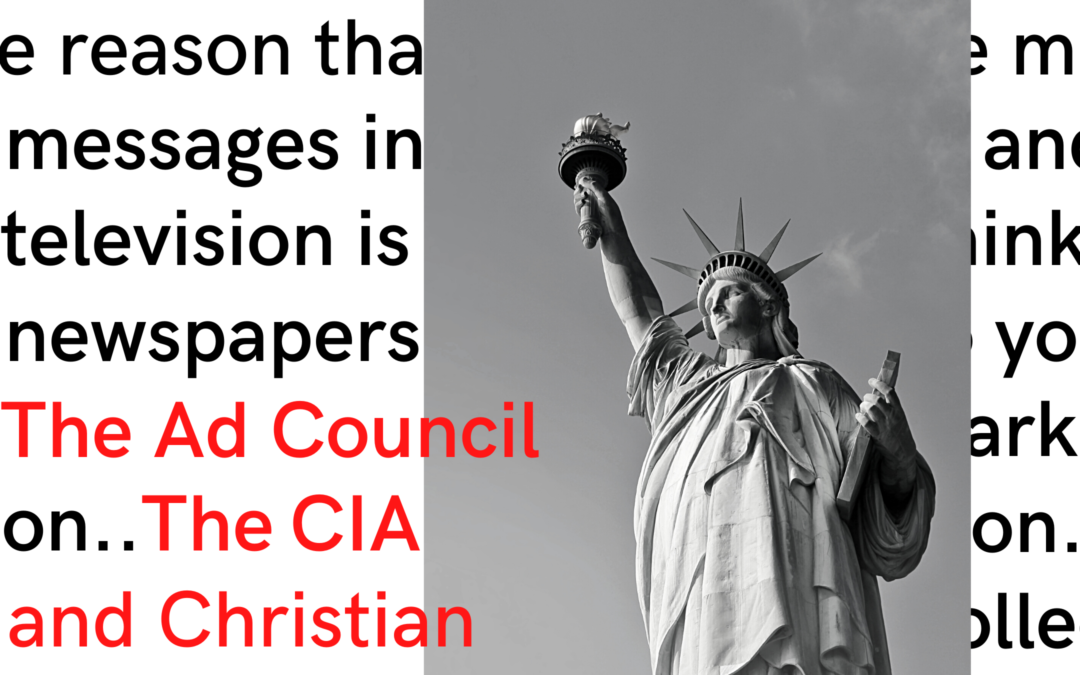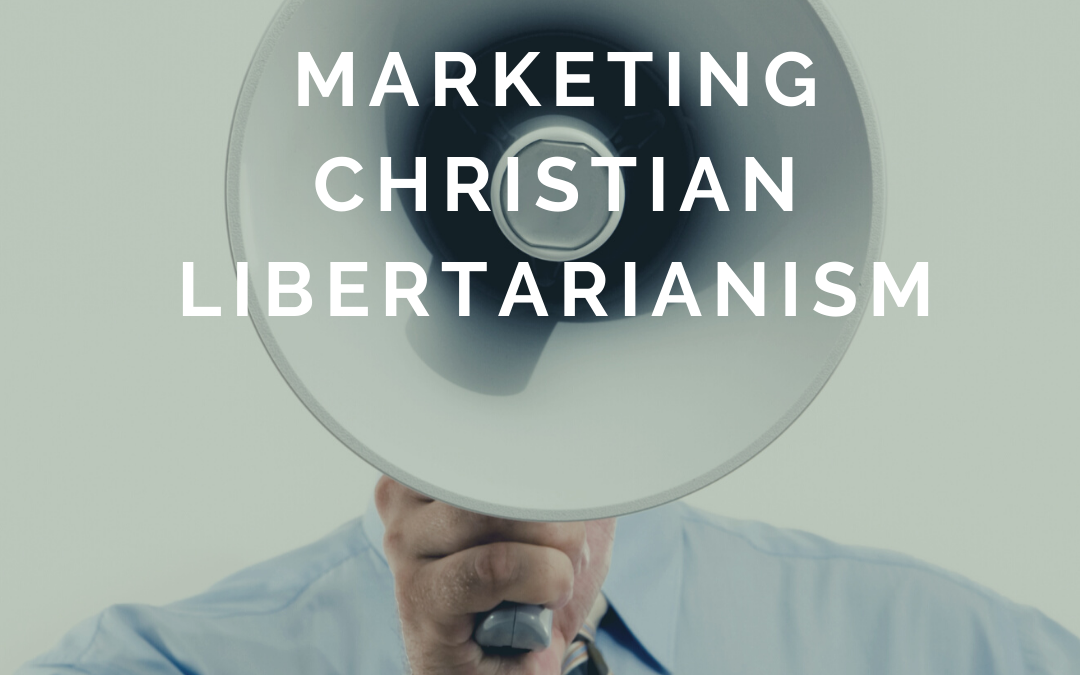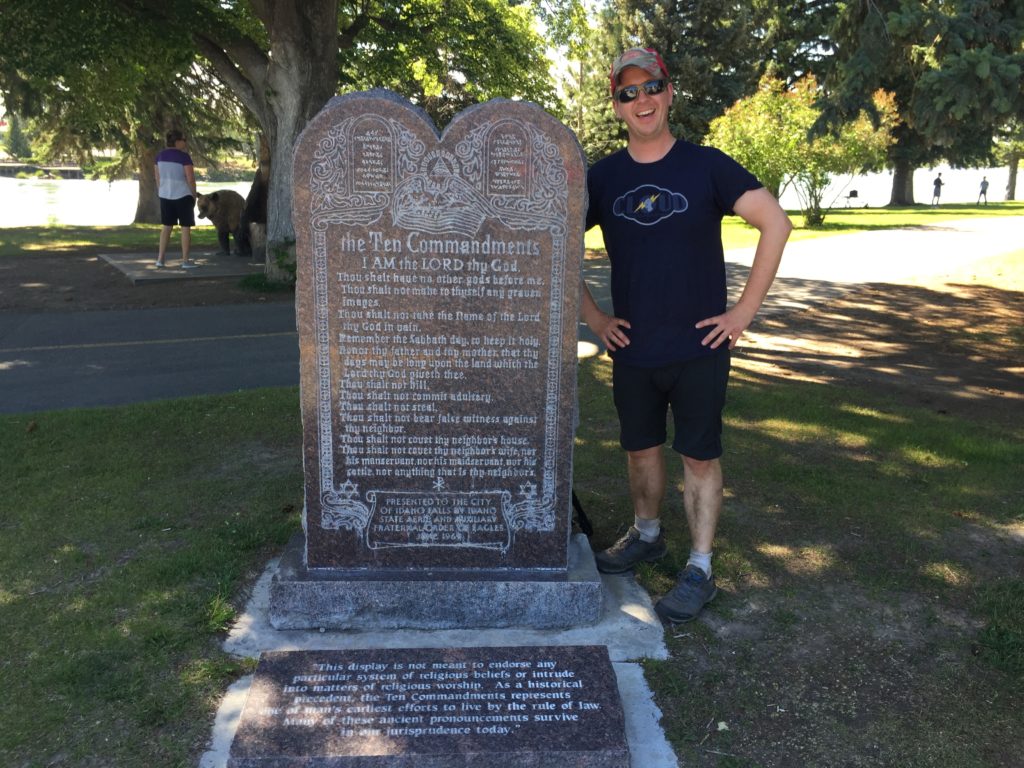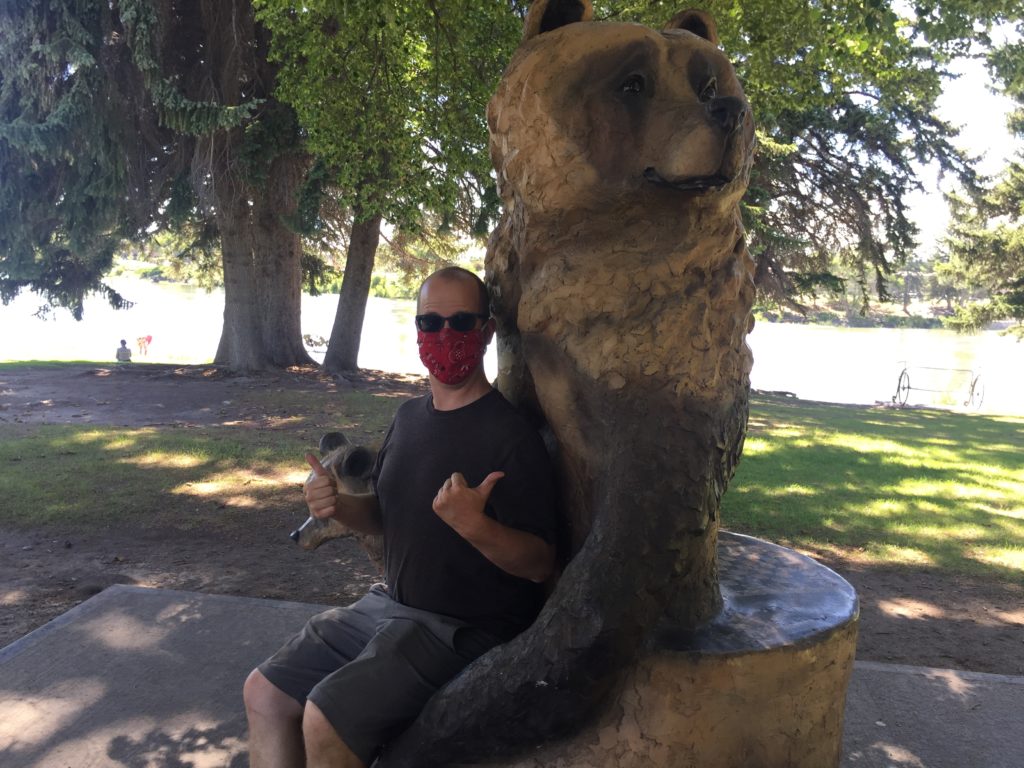
S3:E30 The Ad Council and Christian America (featuring Wendy Melillo)
The CIA and Ad Council targeted propaganda to the American people.
The CIA, big business, and the Ad Council worked together to create the America that we know and love today. Together, they bonded our ideas of patriotism, capitalism, and religion. But not many of us know who the Ad Council is. Sure they created Smokey Bear, the Crash Test Dummies, and the Crying Indian ads… but who are they?
Wendy Melillo, author of “How McGruff and the Crying Indian Changed America: A History of Iconic Ad Council Campaigns” and professor at American University, joins us to discuss her research into the Ad Council.
Helpful Links:
- Religion in American Life Video Ad
- Wendy Melillo’s fascinating lecture on her book
- The creepy “Why?” ad we referenced in the episode
- Ad Council’s own history website
Discussion Questions:
- Have you ever been impacted by advertising? How did it make you feel?
- Does it matter where our ads come from? Even public service announcements?
- How do you feel about the CIA paying for ads to impact Americans?
- Should responsibility for big problems like plastic waste fall on individuals, big corporations, or both?
- Do you think the Bible says anything about one economic model over another?
- What does it mean that the CIA and Ad Council targeted propaganda to the American people?
TRANSCRIPT (note this is an approximation — we’ve got a one person staff and I sometimes miss stuff)
CS: Chris Staron (host)
WM: Wendy Melillo (guest)
Are We Ever Really Free From Advertising?
CS: This episode is a part of a long series exploring how communism in Russia impacted the American Christian Church. This episode can stand on its own, but when you’re done, go back to the beginning of season three for more context.
If you’re out in the wilderness, camping, roasting marshmallows, you might think that advertising is not present. Like, it has no influence on you there. You can sit around the fire, tell stories, and crawl into your sleeping bag knowing that you are out of the reach of the Don Drapers of the world.
Right?
Wait… we skipped a step. Sit around the fire, tell stories, sleeping bag. That’s right… you can’t just leave a fire burning overnight. It could start a forest fire. All of us grew up hearing that only we can prevent forest fires. And who told us that? Smokey the Bear.
WM: One of the things that is interesting about Smokey first is that there is no “the” in his name.
CS: Sorry… Smokey Bear.
WM: Although people will still fight me on this stuff. But the original name is Smokey Bear.
CS: This is Wendy Melillo. She is a Journalism professor at American University and the author of the book “How McGruff and the Crying Indian Changed America”. Smokey Bear’s origin story begins with WWII.
The History of Smokey Bear
WM: What this campaign was all about originally, before the animated beloved character of a bear that everyone has come to know and love, this campaign had to do with protecting our lumber supply.
CS: The world was at war. The United States needed wood to build ships, gun stocks, buildings…
WM: And there was an incident off the California coast where a Japanese submarine fired upon the mainland of America.
A Japanese Submarine Attacked the US Mainland
CS: On February 23, 1942 a Japanese submarine emerged from the water just seven miles north of Santa Barbara, California. They opened fire. Almost two dozen five-inch shells. It was the first time the US mainland was attacked during WWII. The event caused great concern, even though it only destroyed a shed. Could the Japanese use technology to burn down our forests?
That would be terrible for the war effort. Forget about the Japanese for a moment… were Americans here in the states hurting the war effort too? The previous year the Forest Service said there were 208,000 forest fires in the US. 9 out of 10 of which were caused by humans. That’s no joke. Americans were pretty irresponsible with their fire. We had to curb the destruction of this precious resource.
WM: The campaign was created for that reason. But if you look at some of the original advertising, the posters were quite frightening. They had, you know, Hitler. They had Tojo of Japan and they were like menacing faces of those two against the backdrop of a forest on fire.
CS: This was two years before Smokey entered the picture.
WM: And it had slogans like “Careless Matches Aid the Axis” or you’d have “Our Carelessness, Their Secret Weapon”.
CS: The implication was that carelessness was treason. The problem was… this stuff was scary to children. They really are scary. Straight up creepy. So the US Forest Service…
WM: … decided to come up with a more appealing character and animals were doing well at the time because you had the Disney movie out at the time.
CS: This was the era of Fantasia, Dumbo, Little Bambi and his mom (sniff)… I’m cool. Sorry. So the Ad Council came up with… a bear.
WM: Smokey remains the longest running public service advertising campaign in American history.
CS: And everyone loves Smokey, right? I live in Wyoming, we’re surrounded by National Forest. I see Smokey all the time. He’s the best… right?
WM: An academic researcher did this study about how people shoot bullets at posters. Well, people were shooting bullet holes… well, why? Isn’t Smokey loved by everyone?
CS: Ummm… no. Because there are people who like to burn fields for crops. And opinions about forest fires have shifted over the years as people see that they are part of the natural process, clearing old growth, making way for new plants and revitalizing habitats. Parks and forests in the US actually start fires on purpose for that reason. Still… you should put out your campfires.
Why Some People Don’t Like Smokey Bear and the Forest Service
WM: The US Forest Service also represents a lot of negative things to people who live off the land. And who owns the land? Whose land is it? And who took it way back when? You know, all of those arguments that we have about history. This is the only campaign that I can find that is actually protected by an act of Congress. It’s the Smokey Bear Act of 1952 and this prevents anyone from not only using the name Smokey Bear, I mean, not only the image of Smokey to try and profit off of… but the Forest Service controls the words. Anything related to Smokey, you have to get US Forest Service permission to use. Even if it’s for educational purposes.
CS: So… for those of you who were going to run out and sew his face onto socks and hats for your Etsy account… you might want to put a pin in that.
It turns out that advertising is all around us. Even out in the forest. We look at something like Smokey Bear and think it’s pretty cut and dry. He’s there to stop us from burning down the woods. But who is behind these ads? Even ads we might agree with and support?
On this episode, a bear in a forest ranger hat, radio stations in distant lands, communists, Christian America, and the CIA. And the organization that tied them all together: The Ad Council.
You’re listening to the show that uses journalistic tools to look inside the Christian Church. We press pause on the culture wars in order to explore how we got here and how we can do better. I’m Chris Staron. This is Truce.
CS: Okay, so, the Ad Council. Maybe you’ve seen their logo on the bottom corner of a billboard or television commercial. But who is the Ad Council? Back to Wendy.
The History of the Ad Council
WM: For a long time, nearly a decade I was the Washington DC Bureau Chief for Ad Week Magazine. And one of my beats and responsibilities was the Ad Council. And what was so fascinating about the Ad Council is that this was the “do good” part of advertising. This was all about selling good to the American people.
CS: Smokey Bear, McGruff the Crime Fighting Dog, the crying Indian commercial that encouraged us to recycle. That is all the Ad Council.
WM: And this was so different from selling soap or toothpaste or laundry detergent. And I was fascinated by the message development and the strategy behind coming up with the slogans and the visuals that actually persuaded people to do something. Particularly changing behavior, which is not an easy thing to do.
CS: That doesn’t mean it is a bad thing. As we talked about with the Pledge of Allegiance, societies have to encourage their populations to act in a certain way.
WM: When I really started digging into the primary documents I realized, okay, this organization had a very strong, deep rooted background in propaganda on behalf of the federal government.
CS: The Ad Council is not a branch of the US government, but it is sometimes funded by the government. That line is going to get murky here soon, but I wanted to get that out there early on. To understand the creation of the Ad Council, you have to know what advertising was like in the early 1900s.
Advertising Regulation Hasn’t Been Evaluated in Almost 100 Years
WM: You know, the history of advertising involves people who were obviously trying to sell products, but because it wasn’t regulated, really, up until the late 1930s people took liberties. So you had a lot of basically false, deceptive, and misleading advertising. And, understandably, there was a rise in the consumer advocacy movement that pushed back against these kind of false claims.
CS: Nobody was regulating this stuff. Which is especially important to note when it comes to foods and drugs. The American people really should know what is actually in their foods. You shouldn’t have to guess if there is formaldehyde or plaster dust in your milk3. Or roll the dice about whether or not a medicine can really do what it claims. The Franklin Roosevelt administration created the Federal Trade Commission as part of the New Deal… and it had its regulatory eye on the advertising world. Demanding proper labels, at least, for the most part.
WM: And going beyond the false, deceptive, and misleading, you got into the “puffery” aspect. That’s when you inflate the attributes of a product. Buy this deodorant and you’ll be happier, healthier, sexier. Just fill in the blanks with any product.
CS: While consumer groups and the FTC did away with false, deceptive, and misleading ads, they haven’t done away with puffery. You’ll still see it today.
WM: And the last time that our government has seriously looked at regulating advertising goes back to the Wheeler-Lea Act of 1938.
CS: The advertising world decided to get out ahead of this regulation. Demonstrate that they weren’t so bad after all. So they created a non-profit organization to help the government. Do some rebranding of themselves.
WM: Advertisers could say to the federal government, ‘let us help you use our communication and advertising to help you with your policies directed toward the American people.’
CS: That sounds heinous, but it could be something as simple as encouraging people to buy war bonds. Plant victory gardens. Or don’t burn the forest down. As it did during the first World War. In a time of a cold war, it could identify the enemy.
WM: And if you look at Ad Council campaigns, particularly starting in the 1950s as the Cold War starts to get underway, you start to see the values of the people who were involved in the Ad Council playing out in the campaigns.
Smokey Bear Was Created to Fight Hitler and Tojo
CS: They had already used those forest fire ads to identify Hitler and Tojo, the Prime Minister of Japan during WWII, as enemies of the country. During the Cold War, the Ad Council would go to battle with communism and the Soviet Union. The Crusade for Freedom Campaign began in 1950. Not just targeting Americans, but also those in the Soviet Union itself. Part of it was a program called Radio Free Europe.
The History of The CIA’S Involvement With Radio Free Europe
WM: Radio Free Europe became very important at the time for US foreign policy to try to get people in countries behind the Iron Curtain to rise up against the communist influence that they were experiencing in their countries.
CS: Here is how it worked. Set up radio stations…
FAKE ANNOUNCER: You’re listening to Radio Free Europe.
CS: In a friendly nation that can then beam that signal into a communist country.
FAKE: Meaning we can send messages into countries that normally shut out western media and anyone with a radio can hear it for free.
CS: And there’s not much the communist nation could do about it. We’ve done this a lot as the US. Some Christian ministries do it even today to broadcast evangelistic messages into places that are hostile to the gospel. The Ad Council was part of setting up, promoting, and fundraising for Radio Free Europe.
WM: And what people didn’t know is that this campaign was secretly funded by our CIA.
How the US Used the Arts to Influence Communist Countries
CS: Now that records have been opened up, we know that the US government was involved in spreading American culture into the Soviet Union. The controversial American opera Porgy and Bess, which featured a largely black cast was sent in to counteract Russian propaganda about the treatment of African Americans. Which is weird because it’s not a great depiction of black people. Rock bands like Bon Jovi and The Scorpions did a concert in Moscow. All to spread American culture.
In 1951 when a Czech train carrying passengers escaped the Soviet Union by fleeing to West Germany, the Crusade for Freedom campaign sent 2,000 balloons carrying 2 million leaflets about the events into Prague. They took stories of people escaping the Soviet Union and sprinkled them behind the Iron Curtain to encourage more.
Radio Free Europe was like that but in people’s homes. Dropping messages into their living rooms. Encouraging them to rise up against their communist overlords. 29 stations in sixteen languages, supposedly funded by a non-profit. But, really, by the CIA.
WM: And so the messages were messages of liberty, “free yourselves”. It was basically talking about how wonderful democracy is and how wonderful democracy is.
CS: Radio Free Europe was run by the National Committee for a Free Europe. It’s members, it will come as no surprise to you by now, are some of the usual suspects we’ve heard a lot about this season. The president of General Motors, Dwight Eisenhower, and Cecil B. DeMille.
I guess you could expect actions like this in a ideological war. Sending pro-capitalism messages into the enemy camps. Don’t let the narrative be that simple. The campaign also targeted people living in the US.
WM: And so, if you look at the Crusade for Freedom advertising, one headline would be… it’s like a 1950s housewife saying, “I can do something about communism?” Well… give money to Radio Free Europe. The money raised by people mailing in dollars was very little. This was actually a front to help our foreign policy in foreign countries.
CS: The goal of ads like this one wasn’t really to raise money. That was secondary. The objective was to change the minds of Americans when it came to things like communism.
The CIA and Ad Council targeted propaganda to the American people.
WM: Which is not supposed to happen, legally. Because the US government is not supposed to direct propaganda messages like this toward Americans. And so this became quite controversial. The media got on to it back in the 1960s, the late 1960s, that this had been secretly funded by the CIA but a lot of people don’t realize how this stuff can affect us.
CS: The text on that ad claims that $1 would buy “100 words of truth beamed right through the Iron Curtain, Truth to smash Soviet lies, give hope and courage to the 70,000,000 enslaved people behind the Iron Curtain, Truth to stiffen their will to resist, to help keep the Kremlin off balance on its own home grounds.”
Enslaved people behind the Iron Curtain? That’s quite a claim. While Radio Free Europe did send messages behind the Iron Curtain, the real objective was to turn American attitudes against communism in support of US policies.
WM: And when you trace the primary documents, which are the internal memos of the Ad Council, think of an, I don’t know how much you know about advertising. But a famous advertising agency to this day is Chicago based Leo Burnett. Well, Leo Burnett wrote reports in the 1950s talking about the real concern about communism and that the Ad Council needed to be directing its efforts toward promoting the democratic way of life under a capitalistic system. We had to do something to fight the propaganda because Soviet Union was doing the same thing.
CS: You can listen to our episode titled “Godless Utopia” to learn more about Soviet propaganda.
WM: The Crusade for Freedom campaign, which kicks off the decade in the 1950s is followed by a series of Ad Council campaigns like The Miracle of American, the People’s Capitalism… you can kind of see in the names. Traveling exhibits that promoted the American way of life in other countries.
CS: That may seem kind of basic, but let that sink in. Because, after the break, we’re going to talk about how the Ad Council got involved in promoting religion. In the US it can seem confusing how capitalism and religion got linked in our minds. Advertising campaigns like these played a big role.
But those were not the only messages for us. This goes even deeper than radio stations, and crime fighting dogs. Their third campaign is quite startling for us today. It ran for a long time. Remember what we’ve been talking about for the last few months. Communism wasn’t seen just as an economic problem, but as a religious one. Because communism, according to Karl Marx, is inherently atheistic. If the United States and the Ad Council were really going to fight the Soviet Union… they would do it with religion.
I’ll tell you how after these messages.
COMMERCIAL BREAK
The Ad Council Sold Religion to the American People
The Ad Council’s third campaign was called “Religion in American Life”. Wendy doesn’t talk about this in her book, so we’ll come back to her a little later.
The stated purpose of the “Religion in American Life” campaign was (and this is a quote), “to accent the importance of all religious institutions as the basis of American life” and “to urge all Americans to attend the church or synagogue of their choice.”
For example, there was a print ad featuring a group of kids singing. The text below it says, “Democracy starts here… The way I see it… when you’re a father you’re automatically a Founding Father, too. It’s up to you to found America in the heart and mind of every young citizen you add to the census.” At the bottom it reads, “Find yourself through faith, come to church this week.”
I know that went by fast, but what is this ad equating? I’ll play it again so you can count the buzz words.
“Democracy starts here… The way I see it… when you’re a father you’re automatically a Founding Father, too. It’s up to you to found America in the heart and mind of every young citizen you add to the census.” “Find yourself through faith, come to church this week.”
First, democracy.
ACTOR: Vote for me and I’ll make all your dreams come true!
Fathers.
FATHER: Son, let me teach you about tire tread separation. Then we’ll play catch.
Patriotism and the United States.
(clip of the national anthem)
And… faith.
Ahem…. faith… in… in what? It’s not really specific, is it?
“Find yourself through faith, come to church this week.”
Nope. Not specific. By design. Again, this campaign ran during the Cold War. Encouraging Americans to see patriotism, democracy, parenting, and religion as building blocks of our society.
This was not the only ad. Not by far. A filmed ad keeps asking the question: why? (play the sound of why over and over again) It shows people walking in a park. An old woman. Kids playing. A family at a dinner table. The graphic and the voice at the end say, “In a World Looking for Answers Maybe God is the Place to Start. God is hope. God is now.” And it ends with the Ad Council Logo.
This is the McGruff the Crime Dog people! Pro-seat belt. Anti-drunk driving. And they advertised for people to turn to God. A non-specific God.
The Religion in American Life campaign ran at about the same time as Spiritual Mobilization disseminated its information. It all sounds like of innocuous and innocent, doesn’t it? As American as apple pie.
Well… hold up.
Ad Council chairman Stuart Peabody said that, “when you stop to figure it out, there is hardly any Council campaign which doesn’t make some contribution to the health of American business.”
Is it Okay for the Ad Council and American Government to Propagandize the American People?
That may seem like a weird thing to say. But lets you and I think about those PSAs for a moment. That ad with the kids singing urged people to go to church to put America into your kid’s hearts. During the Cold War. How does that benefit business? Well, if they are going to church and are good patriots, it keeps kids away from godless, collectivist communism. Which is great for business, because collectivism means the government would control the means of production. Restrictions. Regulation. Collectivism means you’re not relying on individuals to bargain for their wages, but groups come together to demand certain things for workers. Which all cuts at the bottom line for corporations. The campaign bonded church attendance with Americanism and capitalism. Unregulated capitalism would be their preference. Without all of that New Deal, Social Gospel stuff. I don’t know why we struggle to see regulated capitalism as an option, but we do.
Think about the crash test dummies. How are they good for big business? Keeps insurance companies from having to pay out benefits. Does that mean its bad for society to have seatbelt advertisements? No. Of course not. Seatbelts save lives. But they also benefit insurance companies.
Maybe you’ve noticed that a common theme with a lot of our stories this year has been big business. That’s not by accident. Nor the ways they stand to lose from collectivization. That brings us to another big theme. How do you fight collectivization? By focusing on the individual.
Here again is Wendy Melillo.
WM: What a number of Ad Council campaigns seem to focus on was much more the individual responsibility to do something about a large issue. A societal problem. As opposed to what can we all do together, right?
CS: In the ads, problems aren’t solved by sweeping social change, but by the actions of one person. Only you can prevent forest fires. Doesn’t say anything about faulty electrical equipment that started massive forest fires in California last year, does it? No. It put the onus on the individual.
What about the famous ad where a Native American cries at the sight of litter? The problem is that you didn’t pick up your trash… not that the companies who make the packaging go way overboard. It’s not businesses that are the problem… it’s that you’re not doing your part. There is a big movement out there calling for manufacturers to make less packaging, especially since so much of what we take to our recycling centers is just put into landfills anyway now that China has stopped taking our recycling. It’s not wrong to recycle, but wouldn’t we off to a better start if there were less packaging to begin with?
Okay… take what we know about the ads, the individualism, promoting capitalism, and the American way and apply it to the Religion in American Life campaign. We might be tempted to think they were a little blip on the radar. Think again.
The campaigns were handled by J. Walter Thompson, the largest advertising firm in the world. Maybe they don’t sound like such a big deal. It’s just ads, right? Well, the country was deeply saturated with them. In 1956 alone the Religion in American Life campaign did 5,412 billboards, 9,857 posters in bus and train stops, and 59,590 ad cards inside buses and trains and streetcars.
Local groups could put put prayer cards on restaurant tables, do mailings, and use bumper stickers. A company that wrapped loaves of broad in Columbus, Ohio and another in Wisconsin put labels on their bread promoting the Religion in American Life campaign. 30 millions loaves of bread urged people to go to church.
Like the celebrations Francis Bellamy put together decades earlier to sell flags, local chapters could acquire kits that did the heavy lifting for them. Kits included proclamations that could be signed by mayors, a pre-fab newspaper editorial about the proclamation, and more.
Radio and TV stations were required to run public service announcements. So the Ad Council made some ready-to-go. The ads were everywhere. Really. Everywhere. Buses, radio, television, in print, on the public square. Everywhere.
It’s complicated. As a Christian, I want people to hear about God. But are we okay with all of the trappings that came with the Ad Council? Pro-big business leanings? Tying faith to the United States which means that the actions of the US then reflect back on religion? Does it matter just what an ad says… or should we also know where our ads come from?
WM: I think you have to start in K-12 education. This has to start from the very beginning. Our young people need to be taught that the messages that you are exposed to every day are not necessarily benign. Persuasive communication is very powerful and when I teach it I talk about the continuum. On one end you can have advocacy which can be done for very good causes. And you need to understand what an organization or person is advocating for. But on the other end of that same continuum of persuasive communication is propaganda.
And you have to be very very careful. Because when it goes too far, at what point does it become propaganda? At what point does it become a problem? Particularly with some of the attacks we’ve had against our democratic institutions. And it’s not just the media, though the media has taken some hits. But the judicial system, right? And you can go right down the line. So you have to understand the agenda. What is the agenda behind the campaign? Well, in a 30-second ad, are you going to be able to get that? Especially with an organization like the Ad Council which is very behind the scenes.
It puts up it’s little logo, Ad Council, but nobody really knows what that means. And so, I think it’s important for people to understand that these messages, even if the image is being promoted as selling good, is it really selling good? I think that is a legitimate question to ask. What we have to teach our youngsters in media literacy is a healthy skepticism.
CS: How did Christianity get tied to big business? Through marketing campaigns by James Fifield’s Spiritual Mobilization, Abraham Vereide, and the Ad Council. We’re trained to connect Christianity and capitalism.
Yes, massive campaigns can urge us toward a saving faith in Christ, something I believe in. But they can also act as a distraction, smoke and mirrors that keep us from regulating industries. If libertarian ideas get tied to Christianity, you weirdly end up in a world where Christians are fighting regulatory agencies that are doing nothing to do with the faith. We’re made to fight stuff that we perceive as bad for business. Even if we could never back our stance up with the Bible. Many are backing libertarian ideals under the guise of standing up for Jesus. But are those the same?
We have to be aware of where our ads come from. The messages we hear. The things we equate. Otherwise when the submarine of public opinion surfaces off the shore of our beliefs… we may not survive the fire.
Special thanks to Wendy Melillo. I barely scratched the surface of her book “How McGruff and the Crying Indian Changed America”. We had such a good conversation and I couldn’t use it all. If you give money to support the show you can listen to more of our interview. Details are at trucepodcast.com. I’ve also posted a YouTube video there of one of her lectures on this subject and you can see some of the ads we discussed for yourself.
As always, I’m indebted to Nick Staron who helped me talk through this episode.
It’s been a while since I’ve thanked these guys, but Roy Browning of JMC Brands in Ohio built our awesome website. My friend Andy Huff, author of the Shepherd Suspense novel series, designed the logo.
Truce is listener supported. On what other program are you going to hear a discussion of how the Ad Council shaped Christian America? These episodes take me a long time to research, edit, and post. Your financial help makes a huge difference. You can learn how to give at trucepodcast.com/donate.
Finally, have you left a comment about the show on your podcasting app? It helps people to learn more about the show. Please leave us five stars and tell the world about Truce.
Thanks for listening. We’ll be back in two weeks with more.
I’m Chris Staron. This is Truce.










